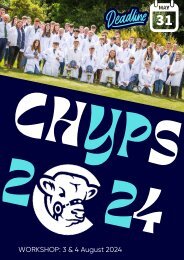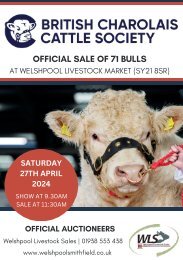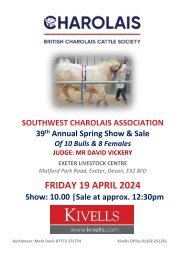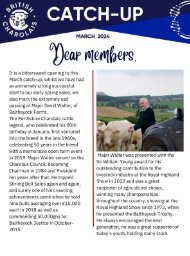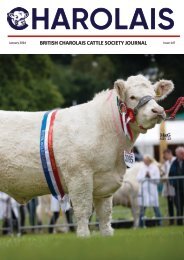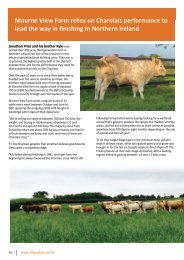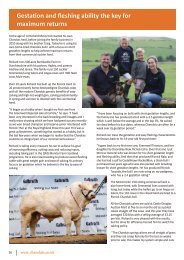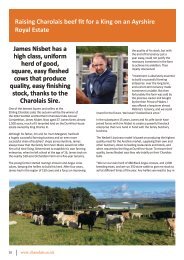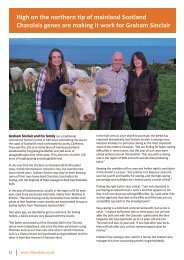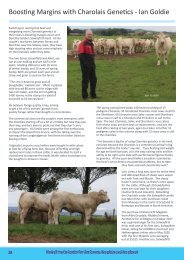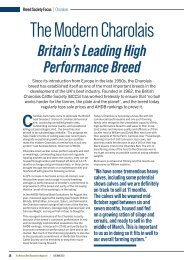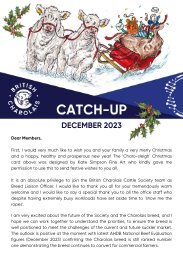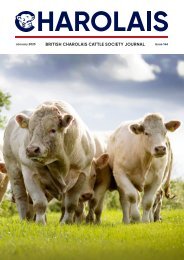BCCS September Newsletter 2022
BCCS September Newsletter 2022
BCCS September Newsletter 2022
- No tags were found...
Create successful ePaper yourself
Turn your PDF publications into a flip-book with our unique Google optimized e-Paper software.
eeding Charolais for hundreds of years – they don’t always<br />
use the easiest calvers or growthiest animals exclusively.”<br />
The Northern Irish regional winner was William Whyte with<br />
his Innisrush herd, with an increase of 6.9 points and a yearend<br />
SRI average of 50.3. The 25-head Innisrush herd is based<br />
in Portglenone,<br />
Co. Antrim, and<br />
William expects<br />
an increase in<br />
numbers to 30<br />
this year.<br />
The herd was<br />
established<br />
in 2003 with<br />
William’s late<br />
father John<br />
Whyte, and the<br />
family became<br />
members of the<br />
society later<br />
that year. The<br />
family originally<br />
operated a<br />
suckler cow &<br />
sheep enterprise<br />
William Whyte and his son John<br />
consisting of 80<br />
cows, of which<br />
7 were pedigree<br />
Charolais, 5 were pedigree Simmental, and the remainder<br />
were commercial cross cows put to a Charolais bull. Upon<br />
John’s passing in 2013, William began to work full-time offfarm<br />
and sold the majority of their stock. He did not part with<br />
his Charolais cows however, and kept them on a hobby basis<br />
where they served as the foundation of the current herd.<br />
The Whyte family have been performance-recording their<br />
cattle since the herd was first established, and William makes<br />
extensive use of EBVs and Selection Indexes when selecting<br />
sires for his cows. He said “I don’t have a stock bull, so I select<br />
all AI sires to match the cows I’m mating them with. In the last<br />
few years I’ve been focusing on high-accuracy Calving Ease<br />
Direct, and 200- & 400-day weight EBVs.”<br />
William went on to add “I’m most focused on breeding a good<br />
female line with good maternal ability, plenty of size and<br />
shape, easy calving with plenty of milk, and correct in feet &<br />
legs with lots of style.”<br />
“I try to produce bulls that the commercial farmer wants, i.e.<br />
easy calving and quick growing with plenty of style. As I work<br />
off-farm, my cows need to be able to calve themselves with<br />
lively calves to get up and suck to give them a good start.”<br />
Finally, the English regional winners were Brian and George<br />
Nancekivell with their Lovistone herd in Okehampton, Devon,<br />
with an improvement of 5.1 points and a year-end average SRI<br />
of 41.0.<br />
A family business, the farm was originally established in 1935<br />
by Will Nancekivell, who then passed the ownership on to his<br />
nephew Brian in 1963. Since then, the farm has grown into a<br />
1150-acre mixed cattle, sheep, and arable enterprise and is<br />
now run by Brian, his son Robert, and his grandson George.<br />
The current 30-head Charolais herd was established in 2001,<br />
following re-stocking after the foot-and-mouth outbreak. The<br />
foundation cows were purchased from the Clayknight herd,<br />
and the first stock bull was Penhole Samaritan. Alongside the<br />
Charolais, the Nancekivell family also keeps a commercial<br />
herd of 60 mainly Saler cows which are put to the Charolais<br />
bull, and they also took on a pedigree Red Ruby Devon herd in<br />
2020.<br />
The Nancekivell family began Performance Recording in<br />
2002, shortly after establishing their Charolais herd. George<br />
explained “We bought our second stock bull, Moynton Bertie,<br />
on the basis of his good EBVs. When we got him home,<br />
we weren’t sure if he would perform like his predecessor<br />
Penhole Samaritan. However, when it came to weighing<br />
Bertie’s progeny, the growth rate in his calves were superior to<br />
Samaritan’s – for us, this was evidence on a practical level that<br />
backed the theory behind BREEDPLAN.”<br />
George Nancekivell pictured with Ben Harman<br />
He went on to add “BREEDPLAN has been a great marketing<br />
tool, people at the farm gate now expect to see a set of EBVs.<br />
Recording for the years we have gives us more confidence<br />
in the bulls that we are selling. In the past, people were put<br />
off by the ‘hard calving’ of the Charolais breed but more and<br />
more people are coming back to it. We have repeat custom<br />
who only want to see bulls with positive Calving Ease Direct<br />
and 400- & 600-day weight EBVs.”<br />
The Nancekivell family believe appearance is very important<br />
when selecting stock, saying “We like an animal with a good<br />
head that carries width right back through her body. When<br />
selecting a stock bull, we focus more on his dam’s line – in<br />
getting the females right, we like to think the rest will sort<br />
itself out! The stock bull has to complement our cows; what<br />
we think they lack, we try and correct with the bull. We’re<br />
hoping our current stock bull Cove Parkranger will inject his<br />
length and size into our cows, and his neat head and clean<br />
body should leave us with some tidy females with good breed<br />
character.”<br />
Alongside selecting the best stock bull for the cows, George<br />
also uses AI on the heifers to expand the diversity within the<br />
herd. He explained “We believe using AI on our heifers has<br />
improved our Self-Replacing Index. We select the very best<br />
figured bulls we can find when selecting for AI. In recent years,<br />
we have gone back to Blelack Digger, which has helped us<br />
leapfrog our average indexes.”<br />
- No bull works harder for the farmer, the plate and the planet - 35<br />
<strong>September</strong> newsletter 22.indd 35 16/09/<strong>2022</strong> 14:59:19




